
Reston Association has officially filled two key leadership positions, the organization announced last week.
Ed Vroom, a former finance director at a Florida-based technology company, took over as the organization’s Chief Financial Officer last week. Vroom worked as the finance director and controller for L3Harris, a company that offers services for federal, civilian, defense and intelligence customers.
Here’s more from RA on Vroom’s background:
Ed managed a team of 25 personnel supporting the Division with offices in Dulles, VA; Columbia, MD; Nashua, NH; Mount Prospect, IL; State College, PA and Melbourne FL. Before L3Harris, Ed was with CACI for 24 years in roles including Program Management, Business Operations and Finance. Earlier in his career, Vroom served in the Navy as the Weapons Control Officer on the USS KIDD (DDG 993), including in the Persian Gulf during Desert Shield/Desert Storm.
RA also hired its first director of environmental resources and education last week. Michael Reynolds, who worked with the National Park Service for nearly 40 years, will take over the newly created position.
Here’s more from RA on his background:
Reynolds brings nearly 40 years of experience with the National Park Service, where he most recently served as the Deputy Director of External and Congressional Affairs for the NPS based in Washington D.C. He previously held leadership positions throughout the US with the NPS, including Yosemite National Park, Cape Cod, Fire Island and Olympic National Parks with regional office leadership assignments in Denver, Philadelphia and Omaha.
RA created the position in order to implement environmental policy established by the Board of Directors and create goals for the association’s environmental resource education and watershed divisions. Other roles include managing services that impact the environment in Reston and organizing educational opportunities and activities for staff and visitors.
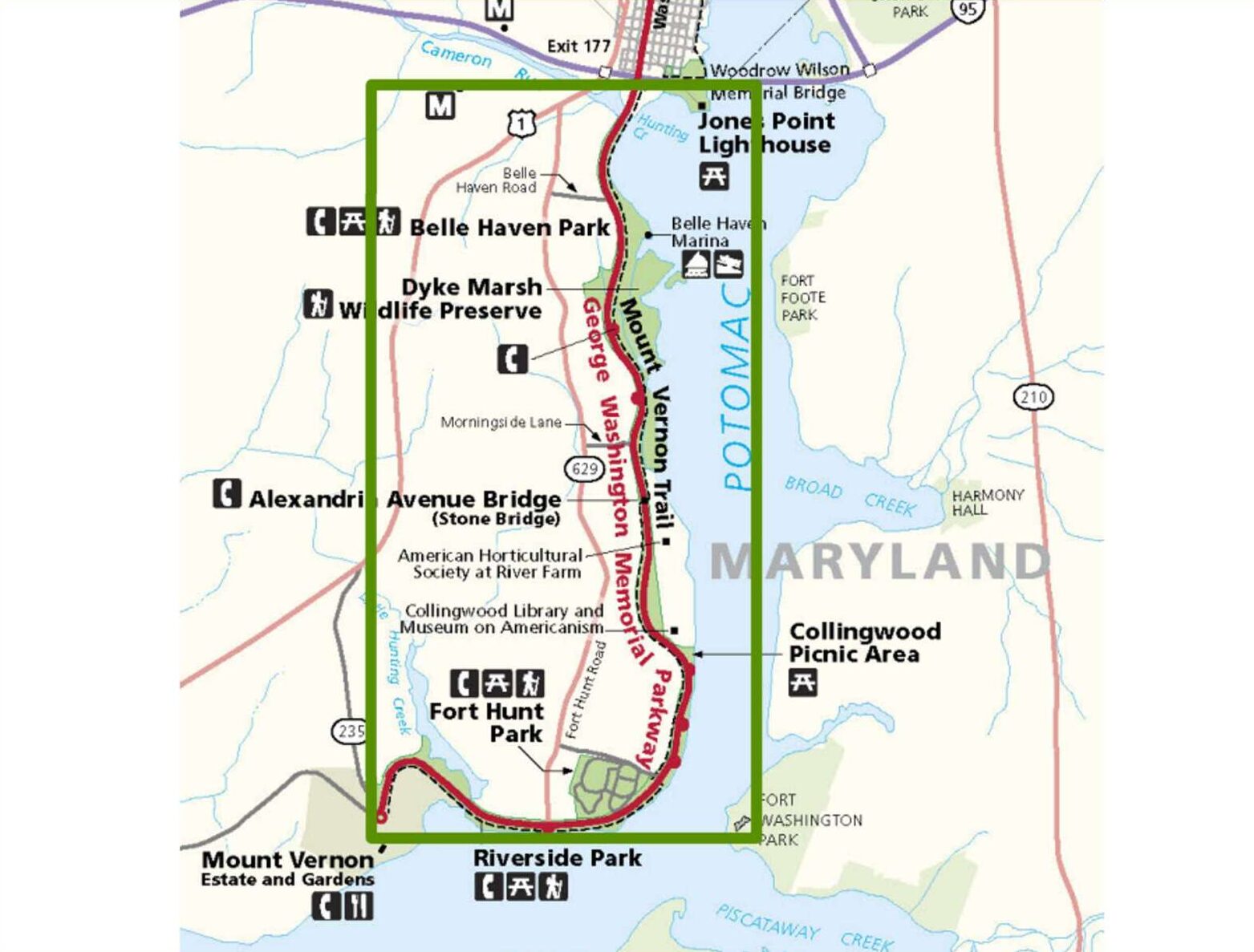
A stretch of the George Washington Memorial Parkway in southern Fairfax County is moving toward some major changes, as is the neighboring Mount Vernon Trail.
The National Park Service, which maintains the GW Parkway and much of the Mount Vernon Trail, plans to start “initial design work and planning for key aspects of the project” this year, per a Jan. 26 press release.
The announcement came after the Environmental Protection Agency released an assessment finding no significant environmental effects from the proposed changes, which will include a road diet and intersection and trail upgrades.
Once work is done, the parkway will be reduced to one southbound travel lane between Mount Vernon and Belle View Boulevard and one northbound lane between Mount Vernon and Tulane Drive. The Mount Vernon Trail, which is typically 8 or 9 feet wide right now, will be expanded to 10 or 12 feet wide in certain areas.
“The primary goal of the project is to enhance safety and reliability for users of the parkway and trail, while preserving the area’s scenic and historic character,” the NPS said. “As vital routes for both local and visiting cyclists, pedestrians, and drivers, these improvements are crucial for the continued enjoyment and safety of everyone who uses these routes.”
The affected portion of the GW Parkway covers about 8.5 miles from George Washington’s Mount Vernon estate (3200 Mount Vernon Memorial Highway) up to the Hunting Creek Bridge south of Alexandria City. According to the NPS, neither the south section of the Parkway nor its drainage systems has had a “comprehensive rehabilitation” since it was constructed in 1932.
Other changes will include a replacement of road surface that the NPS characterizes as “deteriorated” and improvements to drainage and stormwater management.
On the portion of the roadway with a road diet, the plan is to set up two right-hand shoulders or, at southbound intersections, right-turn lanes. Plus, the road will feature a new striped median or center turn lane.
A number of intersections will also see updates intended to make them safer, including the ones with Vernon View Drive, Waynewood Blvd and the access to Tulane Drive, Belle View Blvd and Morningside Lane. A study of crashes on GW Parkway in 2005-2015 and 2018-2019 revealed crashes were most severe at intersections with those roadways, mostly due to vehicle speeds.
Select intersections will also get crosswalks.
The NPS-administered portions of the Mount Vernon Trail will also see stormwater management improvements. Four trail bridges will be replaced, and repairs are planned for 29 more.
The planned trail widening comes nearly four years after NPS finished a study that determined the trail is “relatively narrow by modern standards.”
A full construction schedule and traffic management plan will come after initial design work and planning, but NPS documents indicate that the trail will remain usable to pedestrians and cyclists during construction. Closed sections will be serviced by alternate routes and temporary detours.
The affected section of the GW Parkway may see temporary lane closures, and access to its “recreational, natural, and cultural areas” may be restricted during construction, per the environmental assessment for the project.
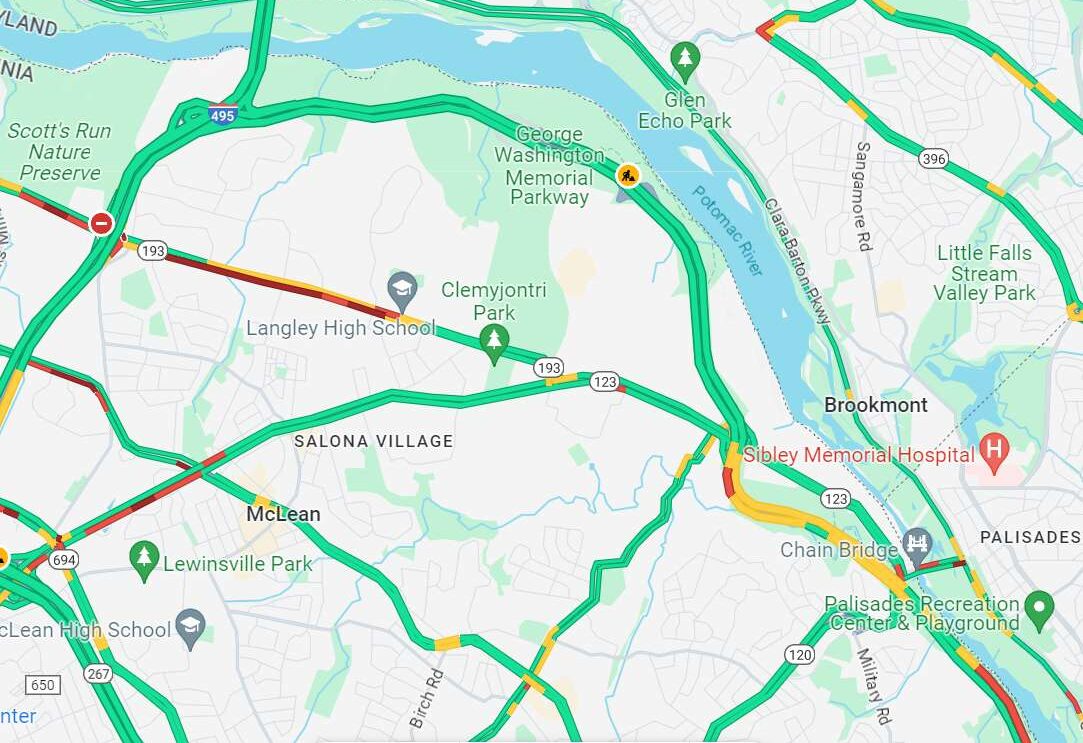
Snow remains on the ground after the D.C. area’s biggest snowstorm in two years, but the George Washington Memorial Parkway at least has reopened for traffic.
The roadway’s northern section from I-495 (Capital Beltway) in McLean to Spout Run in Arlington had been closed since Monday morning (Jan. 15) in response to the forecasted snow, which was expected to exceed 2 inches.
The National Park Service announced this morning (Wednesday) that the GW Parkway is open again, but northbound and southbound traffic are each confined to one lane in the stretch that’s under construction as part of an ongoing rehabilitation project.
“Drivers should continue to stay alert while driving through the construction zone, observe traffic signs, respect the 40-mph speed limit, expect delays through narrow travel lanes, and plan alternate routes,” the NPS said.
Fairfax Connector resumed regular service today after operating on a reduced schedule since 8 p.m. on Monday, though the bus system warned that some routes are using detours due to road conditions. Metrobus is also running nearly all bus routes on a regular schedule with some detours.
With temperatures dropping into the teens this morning, or even as low as 9 degrees at Dulles International Airport, the Virginia Department of Transportation cautioned travelers to watch out for icy spots on roads and pavement.
According to preliminary totals from the National Weather Service, snowfall totals in Fairfax County ranged from 2.8 inches in Lorton to 4.8 inches reported in Herndon and Vienna. Inside the Beltway, the county recorded roughly 3.5 inches.
This was the first time in 728 days that the D.C. region got more than an inch of snow, according to the Capital Weather Gang.
The storm prompted Fairfax County Public Schools to call a snow day yesterday — its first since 2022. The school system resumed classes today on a two-hour delay.
Baltimore and Washington DC metros picked up the most snow since 2022. Here's a map (followed by a county-by-county list) of the snow and ice totals from this recent event: https://t.co/a1FgB0Rumy. #MDwx #VAwx #WVwx #DCwx pic.twitter.com/aCjogoNpPr
— NWS Baltimore-Washington (@NWS_BaltWash) January 16, 2024
Use caution this morning, with temps in the teens and single digits, residual #icy spots are likely.
We have crews out this morning spot treating as needed. You can submit a request at https://t.co/12wxgee8pi or 800-FOR-ROAD. pic.twitter.com/eSHnfafxof
— VDOT Northern VA (@VaDOTNOVA) January 17, 2024
Image via Google Maps
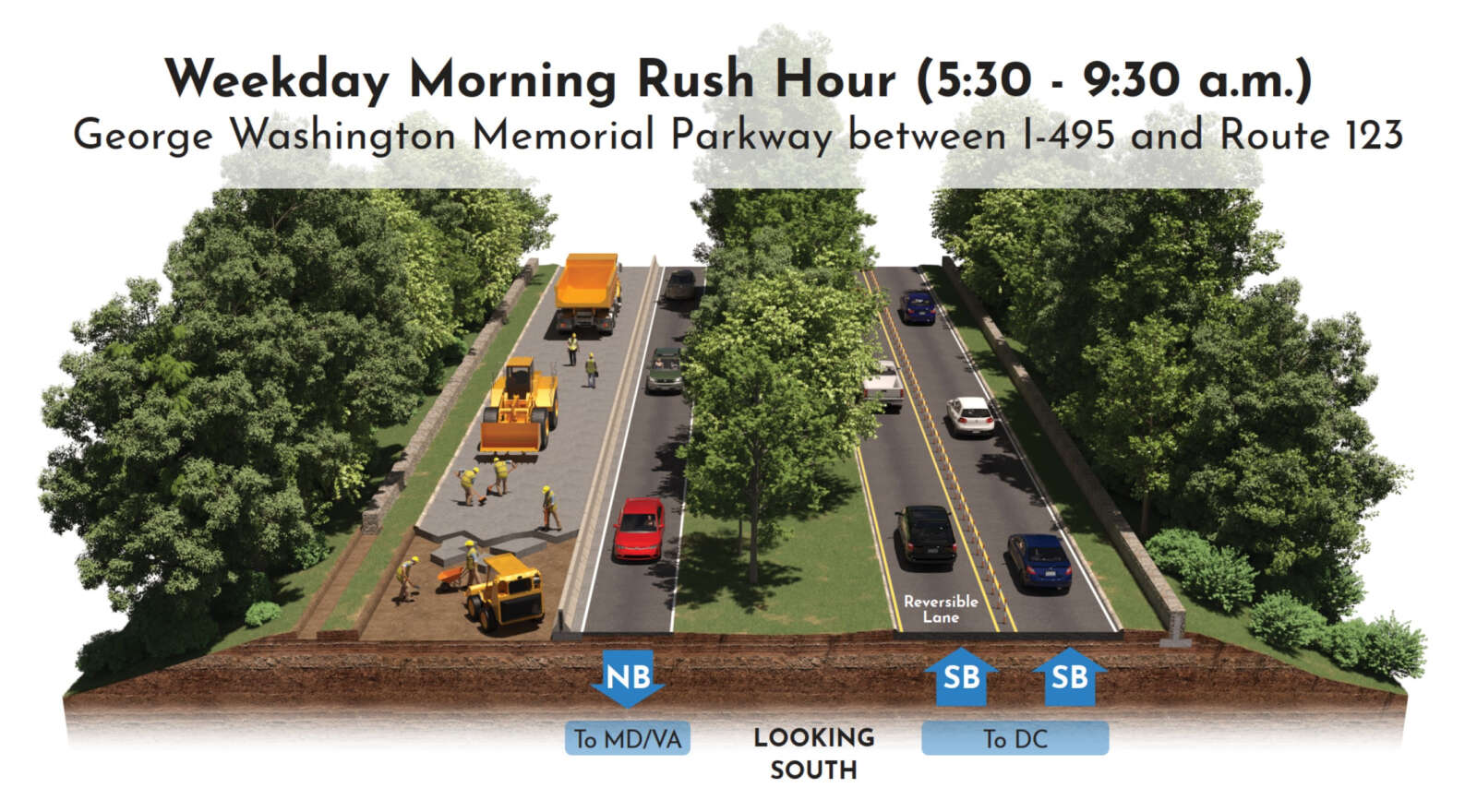
The GW Parkway’s northern section is on the brink of a new phase in its rehabilitation process.
Starting tomorrow (Saturday), construction on the George Washington Memorial Parkway in McLean will shift from the southbound lanes to the northbound ones between the Capital Beltway (I-495) and Route 123 (Chain Bridge Road).
The traffic shift will be implemented over roughly three days, necessitating single-lane closures on the parkway’s northbound side starting at 8 p.m. today (Friday) until 2:45 p.m. on Monday, Jan. 8.
The new traffic pattern will require all drivers headed north toward Maryland to use a temporary, reversible lane that first opened in the parkway’s median last April, when construction began on the southbound lanes, the National Park Service announced.
“The left southbound lane (closest to the median) will serve as the reversible lane, which provides flexibility to change direction for morning and evening rush hours,” the NPS said. “The right southbound lane will always serve as a southbound lane.”
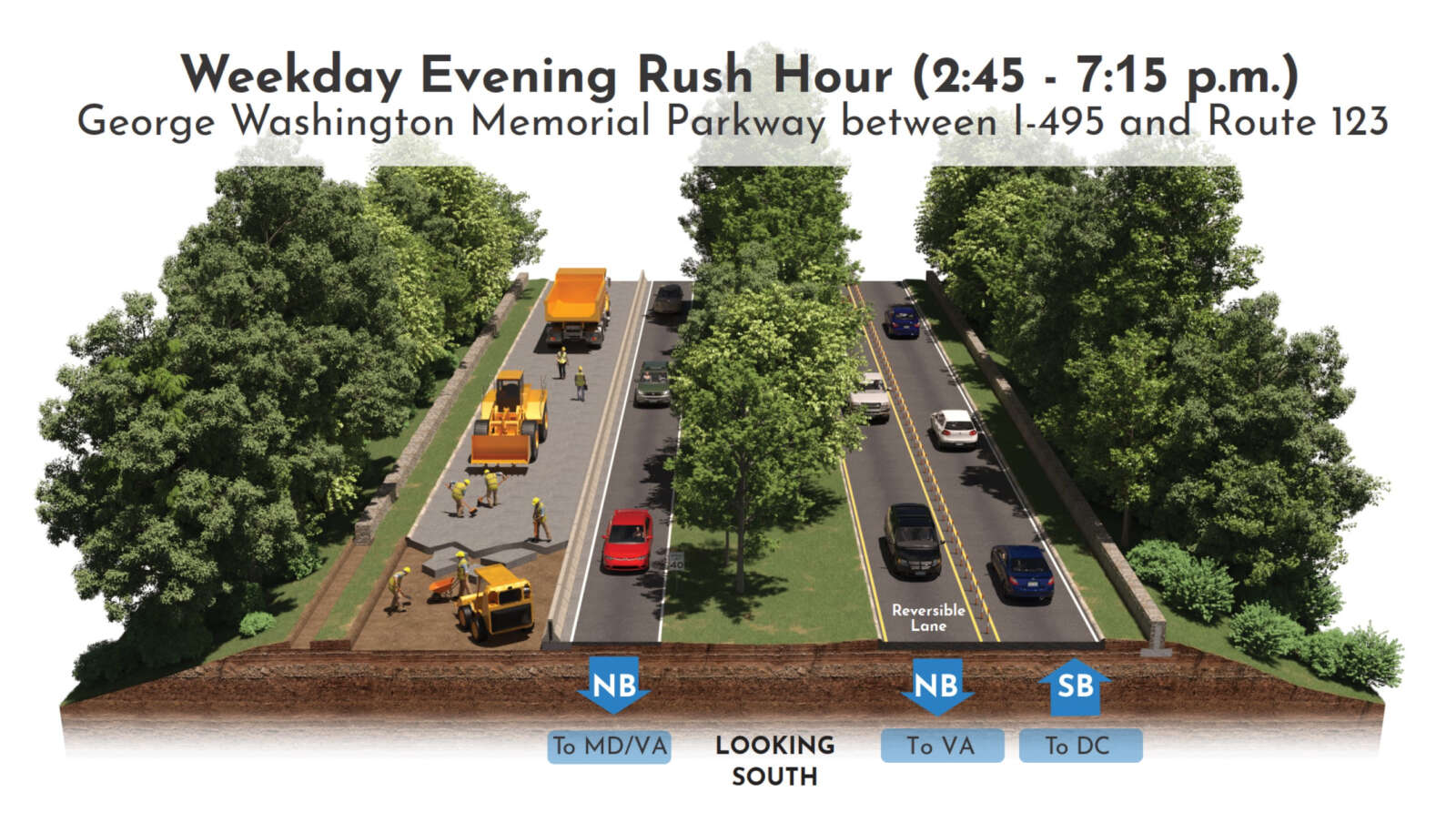
Here’s from the National Park Service on the new traffic pattern, which will be in effect for the remainder of construction through late 2025:
Weekday morning rush hour (5:30 a.m. – 9:30 a.m.)
- Two lanes southbound (toward Washington, DC).
- Drivers who need to exit at Route 123 or CIA Headquarters must use the right lane.
- One lane northbound (toward Maryland/Virginia).
Weekday evening rush hour (2:45 p.m. – 7:15 p.m.)
- Two lanes northbound (toward Maryland/Virginia).
- Drivers who need to exit at Route 123 or CIA Headquarters must use the right lane.
- Drivers heading toward Maryland must use the right lane.
- Drivers heading toward Virginia via I-495 must use the left lane (the reversible lane).
- One lane southbound (toward Washington, DC).
Weekdays (9:30 a.m. – 2:45 p.m.) and weekends/holidays
- One lane southbound (toward Washington, DC).
- One lane northbound (toward Maryland/Virginia).
Drivers should observe traffic signs, respect the 40-mph speed limit, expect delays through narrow travel lanes and plan alternate routes. Vehicles with a gross vehicle weight over 10,000 lbs. are always prohibited from using the parkway.
This traffic pattern allows the project crews greater access to the roadway, which will reduce the time needed to complete the project. Temporary concrete barriers will be placed along the northbound lane throughout January to create a safer work zone for crews.
NPS notes that the timing of the traffic shift and the reversible lane schedule could change if there’s snow or other inclement weather — a strong possibility this weekend, current forecasts suggest.
The northern portion of the parkway will shut down four hours before any storm that’s expected to bring two or more inches of snow or any freezing rain or ice.
Announced in 2021, the North Parkway Rehabilitation Project will update the GW Parkway from the Beltway to Sprout Run in Alexandria with a redesigned Route 123 (Chain Bridge Road) interchange, new asphalt paving, stormwater management system repairs, extended entrance and exit lanes and other improvements.
Wolf Trap National Park for the Performing Arts won’t unveil the artists booked for its upcoming summer season for a few more weeks, likely in late January or early February. But regardless of who’s on stage, Filene Center visitors can expect at least one improvement in 2024: an updated concessions area.
Construction on the new Meadow Commons building began in September after the demolition of the existing concessions stand, which had served patrons since the Filene Center opened in 1971.
Almost twice the size of its two-story predecessor, the three-story Meadow Commons is on track for completion in late spring, according to the Wolf Trap Foundation for the Performing Arts, the nonprofit that helps fund and program the park. That would be in time for the new season, which typically kicks off around Memorial Day.
“This new building will create just a wonderful new opportunity for patrons,” Beth Brummel, the foundation’s chief operating officer, said. “It’s probably one of the more visible [improvements] because it’s so connected to the experience of going to the concerts as well…So, we’re just really excited about it.”
Featuring a larger, modernized kitchen that can support a bigger menu as well as expanded restrooms, including family and ADA-accessible stalls, Meadow Commons constitutes the second phase of renovations slated for Wolf Trap under a park master plan updated in 2022.
The first phase replaced temporary vinyl tents near the Ovations restaurant with permanent pavilions. Finished in late July 2021, that project coincided with the park’s 50th anniversary season and aimed to encourage more year-round usage and visitation.
Meadow Commons, a $15 million project funded by a capital campaign that ultimately drew $75 million from donors over two years, was designed to improve the patron experience and make the Filene Center more accessible, Brummel says.
The new building will include elevators that finally connect the 7,000-seat amphitheater’s upper and lower levels, which can currently only be reached by stairs. The park’s lower levels will also be easier to access from the ADA parking and the picnic pavilions via a new, fully accessible path.
“The restrooms, the food service and the elevator in particular is a game changer to allow people with any kind of mobility issues to be able to access all of the different levels of the Filene Center without assistance,” Wolf Trap National Park Superintendent Ken Bigley said, adding that the National Park Service is “so thankful for the foundation’s support in making this happen.”
The accessibility improvements build off an earlier reconfiguration of the Filene Center’s front orchestra, which now have aisles so those seats could be reached from the back, Brummel noted. The amphitheater was also outfitted with screens in 2018 to give patrons on the lawn a better view of the stage.
In addition to the enhanced accessibility and expanded restroom and concessions space, Meadow Commons will bring modernized electrical, plumbing and stormwater management capabilities and a rooftop deck that will offer a panoramic view of the surrounding meadow and woods.
“I think it’s one of the flagship views of the park,” Bigley said. “So, there’s a section of this new building that will allow people to sit and enjoy a meal or enjoy a drink and look out on this beautiful view of the meadow.”
The upgrades at Wolf Trap won’t stop with the new concession area. Other changes proposed by the master plan include a pedestrian tunnel to replace the existing at-grade crossing at Main Circle and Barn roads, a new arrival hub, a 65-space accessible parking lot and a reconfigured circle in front of the Filene Center’s main gate to improve vehicle circulation.
Brummel says the Wolf Trap Foundation and National Park Service haven’t established a list of priorities or schedule for those additional projects yet. For now, they’re just looking forward to finishing Meadow Commons and seeing how it’s received by visitors when the Filene Center reopens.
“We’re excited [to make] the action, the process of visiting Wolf Trap to be just a little bit easier, whether it’s food service or accessibility or restrooms,” Bigley said. “It is already a very special place that we’re very proud of, and this will just take it to the next level.”
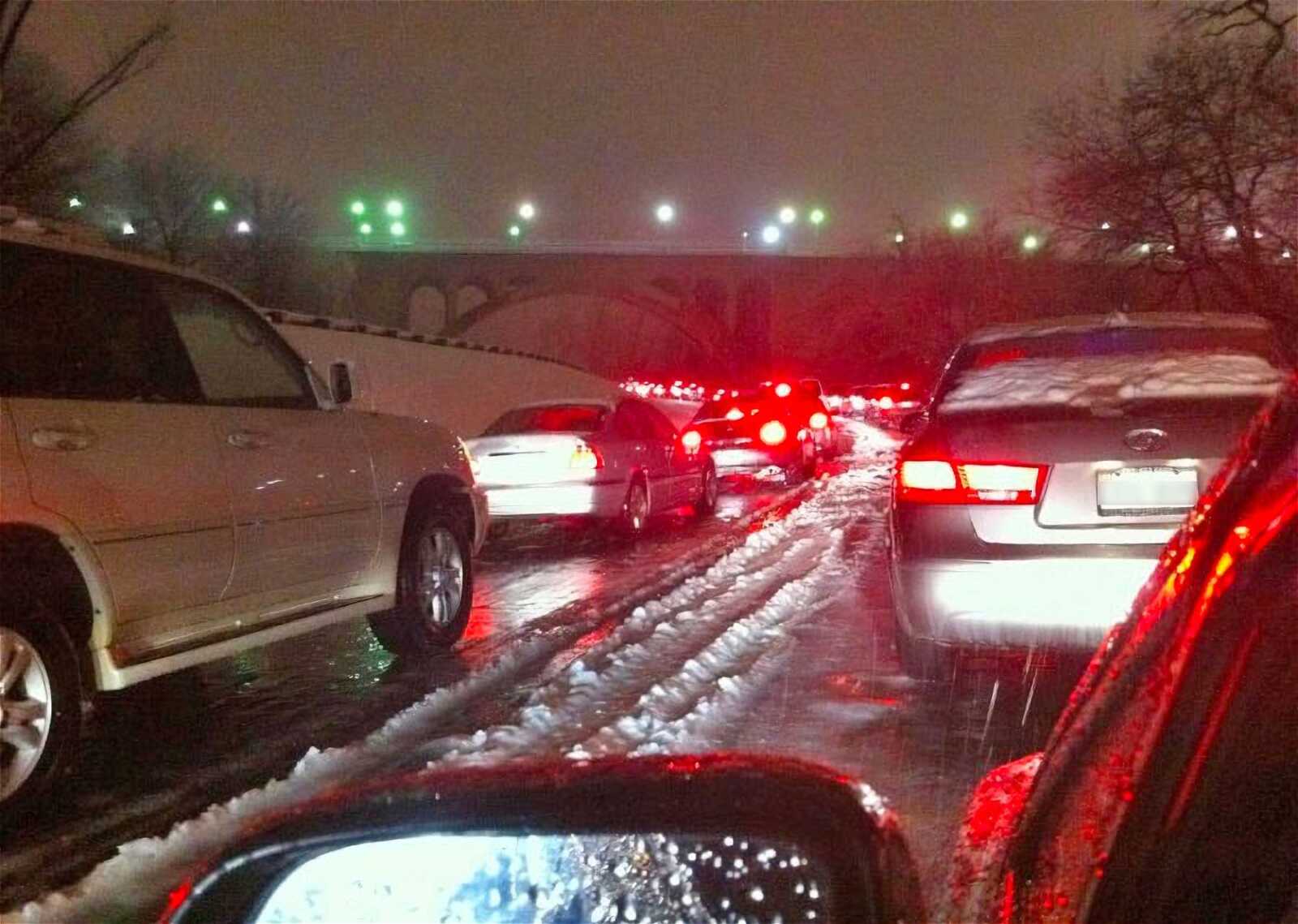
The National Park Service is warning commuters of potential shutdowns of the GW Parkway in the event of winter weather.
The northern portion of the George Washington Memorial Parkway will close in advance of storms forecasting two or more inches of snow and any amount of freezing rain or ice, NPS said in a press release Wednesday. The road will close four hours before the forecasted start of the storm and drivers will need to seek alternate routes.
The announcement comes amid construction on the ongoing North Parkway Rehabilitation Project, which has resulted in narrower lane widths and a reversible-lane traffic pattern. The work is taking place between Spout Run Parkway in Arlington and the Beltway in McLean.
“Bad weather could shift the reversible lane schedule or close the parkway,” the park service said. “The NPS will pre-treat roads, however treating the road and removing snow will take more time because snow removal crews need to use smaller equipment to fit in the narrower lanes.”
Drivers should also expect delays in reopening the northern section of the parkway while crews clear snow and treat other sections of the parkway and park areas, the release noted. NPS urged drivers to follow traffic signs and the 40 mph speed limit.
The rehabilitation project was announced two years ago. The National Park Service and the Federal Highway Administration awarded a $161 million contract for the project “to improve driving experience, safety and water drainage while retaining and reviving the historic beauty and significance of the parkway.”
The northern section of the parkway has seen frequent potholes and other rough driving conditions, in addition to occasional sinkholes prompting full closures. Weather has also prompted closures in the past, stranding drivers during snowstorms and blocking the parkway with fallen trees during summer storms.
More, below, from the National Park Service.
As winter approaches, construction on the North Parkway Rehabilitation Project continues with narrower lane widths and a reversible-lane traffic pattern. Bad weather could shift the reversible lane schedule or close the parkway. Drivers should be aware of the following and plan accordingly. The northern section of the parkway:
- Will close for storms forecasting 2 or more inches of snow or any amount of freezing rain or ice. The road will close 4 hours before the forecasted start of the storm. Drivers will need to seek alternate routes.
- Will remain open for storms forecasting fewer than 2 inches of snow and no freezing rain or ice.
The NPS will pre-treat roads, however treating the road and removing snow will take more time because snow removal crews need to use smaller equipment to fit in the narrower lanes. Drivers should expect delays in reopening the northern section of the parkway while crews clear snow and treat other sections of the parkway and park areas. Throughout the project, drivers should observe traffic signs, respect the 40-mph speed limit, expect delays through narrow travel lanes and seek alternate routes. Commercial vehicles are always prohibited from using the parkway.
Where to find more information
Closure and re-opening information will be shared with GWMP Rehabilitation project news subscribers. Drivers can view construction updates and opt-in to receive emails about traffic impacts, meetings and major project milestones. Updates about road closures may also be posted on social media.
This story was originally published by FFXnow’s sister site ARLnow.
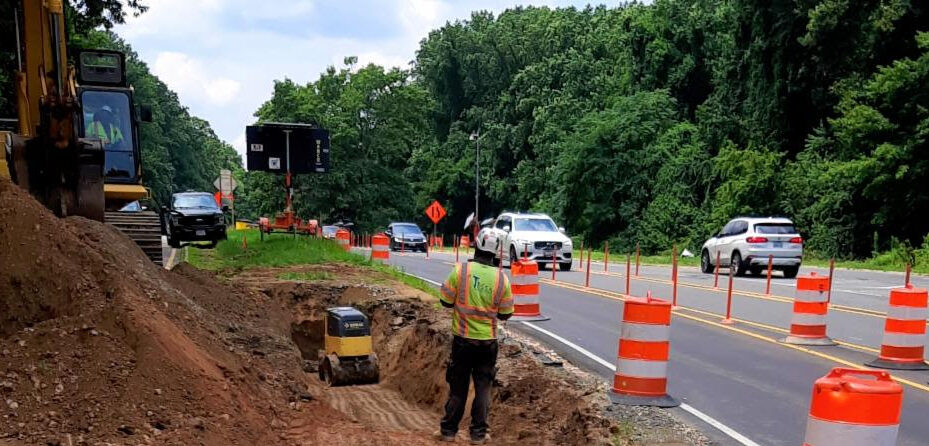
For the next couple of weeks, sunset will provide no relief from construction on the George Washington Memorial Parkway in northern McLean.
Starting tomorrow (Friday), crews will spend the hours between 8 p.m. and 6 a.m. each day pouring concrete on the surfaces of the Dead Run and Turkey Run bridges, the National Park Service announced on Tuesday (Aug. 22).
“Nightwork will occur intermittently through early September,” the NPS said in a news alert. “Work will occur on one bridge at a time. One lane of travel will be open in each direction; no additional lane closures are anticipated for this work.”
The agency advises drivers to “observe traffic signs, respect the 40-mph speed limit, and watch for crews working along the parkway,” noting that construction signage and message boards will be placed along the roadway.
“In the event of inclement weather, night work will be postponed to the following night,” the NPS said. “Motorists should anticipate delays and plan for additional travel time or consider taking an alternate route.”
The construction work is part of the GW Parkway rehabilitation project, a $161 million effort to upgrade the aging roadway first built in 1962. The project includes asphalt repaving, a redesign of the Route 123 (Chain Bridge Road) interchange, stormwater management system repairs, extensions of some entrance and exit lanes, and improvements to stone walls, roadside barriers and historic overlooks.
Construction began in July 2022 and is expected to continue into December 2025.
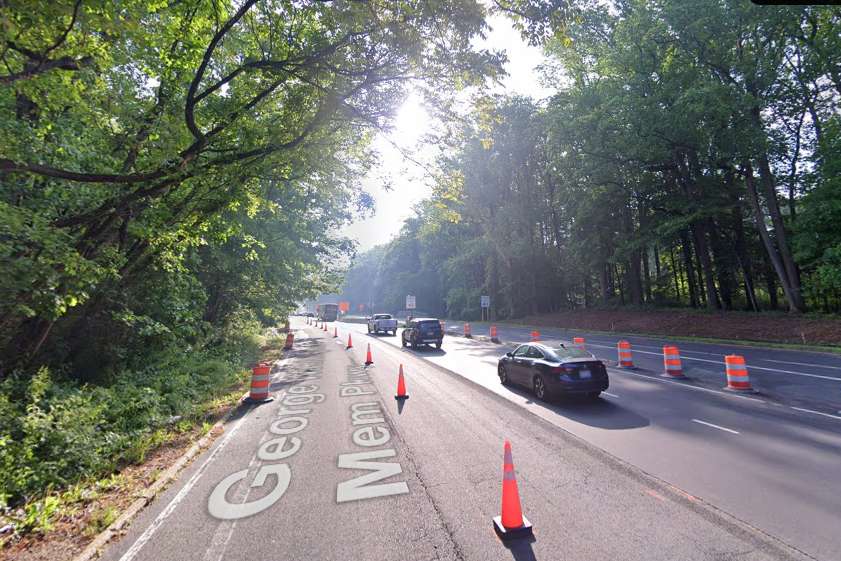
It took four days of work, but all trees have finally been cleared from the George Washington Memorial Parkway.
The parkway’s northern section between the Capital Beltway (I-495) in McLean and Spout Run Parkway in Arlington reopened at 9:45 a.m. today after hundreds of trees downed by a storm on Saturday (July 29) necessitated an extended closure.
The northbound lane reopened at 1 p.m. yesterday (Tuesday), but the southbound lane weren’t cleared until this morning, according to the National Park Service.
The GW Parkway will be fully operational for the afternoon rush-hour.
Drivers should use caution as the 3-lane traffic configuration is still in effect for the north parkway rehabilitation project.
— National Parks of Greater Washington, DC (@NPSNewsDC) August 2, 2023
“We extend our sincere appreciation to the public for their patience and understanding during this closure period,” GW Parkway Superintendent Charles Cuvelier said. “The safety of our visitors and commuters remains our top priority. We are dedicated to ensuring their well-being and convenience throughout their journey on the George Washington Memorial Parkway.”
As of yesterday, clean-up crews had removed up to 325 trees from the roadway, creating more than 500 tons of wood and debris that filled up 100 dump trucks and 15 chipper trucks, the NPS previously said.
The NPS noted that drivers should still be cautious around ongoing construction to rehabilitate the parkway. The project required the addition of a third, reversible lane in the median that has been in effect since April.
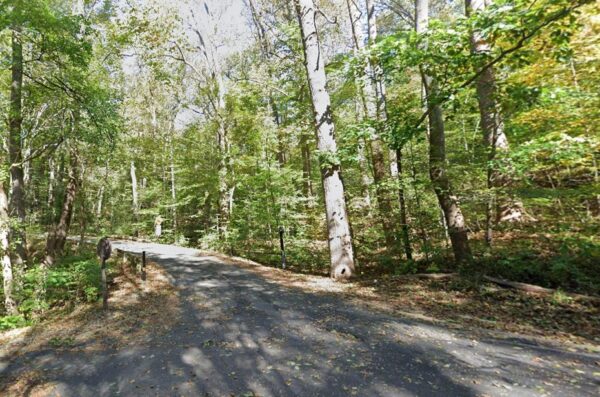
For the next six months, anyone who wants to visit Turkey Run Park in McLean will have to get there on foot.
All parking lots and the Turkey Run Loop Road that leads into the park from the George Washington Memorial Parkway will close today (Monday) for repair and repaving work, the National Park Service (NPS) announced this morning.
The park and its trails will still be open, but the only way to access them will be by walking on the Potomac Heritage National Scenic Trail.
“The NPS will mill and resurface Turkey Run Loop Road and the parking lots within the park,” the park service said in a news release. “The NPS will complete full depth repairs for some road surfaces. All repaired pavement surfaces will also receive new pavement markings.”
The road and parking lot closures will remain in place through construction, which is expected to finish by Sept. 30.
According to the NPS, the road project is being funded by park entrance fees, which can be used “for construction projects that directly enhance visitors’ enjoyment and access.”
The scope of the closures is necessary for “safety and security protections” during construction, a record of determination approved by GW Parkway Superintendent Charles Cuvelier on March 23 says.
“The project will improve the driving experience and safety while retaining the beauty of the park,” the NPS said. “…The closures will not adversely affect the park’s natural, aesthetic, or cultural values. The closures do not require significant modification to the resource management objectives and are not of a highly controversial nature since this is similar to closures that have occurred in the past.”
Photo via Google Maps
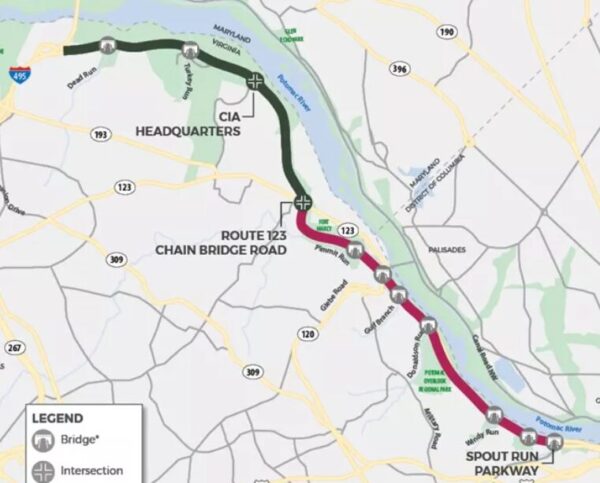
Updated at 12:55 p.m. on 4/14/2023 — The National Park Service has delayed the GW Parkway changes due to forecasts calling for inclement weather over the weekend. The lane shift is now expected to begin around April 21-24.
Earlier: Drivers will soon have to get accustomed to a brand-new traffic pattern on the McLean section of the George Washington Memorial Parkway.
Starting Saturday, April 15, the existing southbound lanes will close between the Capital Beltway (I-495) and Route 123 (Dolley Madison Blvd and Chain Bridge Road) so crews can begin rehabilitating that portion of the roadway.
All traffic will shift to the northbound lanes, which have been expanded with the addition of a third, temporary lane in the median. The new lane will change directions based on where rush-hour traffic is headed.
“This temporary lane will serve as a reversible lane, which provides flexibility to change direction for morning and evening rush hours,” the National Park Service said in a news release yesterday (Monday). “This traffic pattern allows the project contractor greater access to the roadway, which will reduce the time needed to complete the project.”
If there’s inclement weather on April 15, the new traffic pattern will commence on Saturday, April 22 instead.
On April 15, the NPS will implement a new, temporary traffic pattern on George Washington Memorial Parkway between I-495 and Route 123 for the next phase of the North Parkway Rehabilitation Project: https://t.co/3yjIWOU0hL pic.twitter.com/PFFBTyoNQ0
— National Parks of Greater Washington, DC (@NPSNewsDC) April 3, 2023
According to the NPS, here is the daily schedule for the reversible lane:
Weekday morning rush hour (5:30 a.m.-9:30 a.m.)
- Two lanes southbound (toward Washington, DC).
- Drivers who need to exit at Route 123 or CIA Headquarters must use the right lane.
- One lane northbound (toward Maryland/Virginia).
Weekday evening rush hour (2:45 p.m.-7:15 p.m.)
- Two lanes northbound (toward Maryland/Virginia).
- Drivers who need to exit at Route 123 or CIA Headquarters must use the right lane.
- One lane southbound (toward Washington, DC).
Weekdays (9:30 a.m.-2:45 p.m.) and weekends
- One lane southbound (toward Washington, DC).
- One lane northbound (toward Maryland/Virginia).
The park service advises drivers to pay attention to traffic signs, adhere to the roadway’s 40 mph speed limit, and prepare for potential delays.
“To increase safety, small physical barriers will divide the narrow, 10-foot-wide lanes,” the NPS said, noting that vehicles that weigh over 10,000 pounds will still be barred from the parkway.
Federal officials broke ground on the north GW Parkway rehabilitation in July 2022. The approximately $161 million project will update the parkway’s northern section — from the Beltway to Sprout Run in Arlington — for the first time since it was originally completed in 1962.
Funded by the Great American Outdoors Act, which was passed in 2020 to support infrastructure and recreational improvements on public lands, the project will install new pavement, redesign the Route 123 interchange, repair stormwater facilities, lengthen some entrance and exit lanes, and more.
The NPS anticipates the three-lane pattern remaining in place throughout the rest of construction, which is projected to finish in December 2025.

